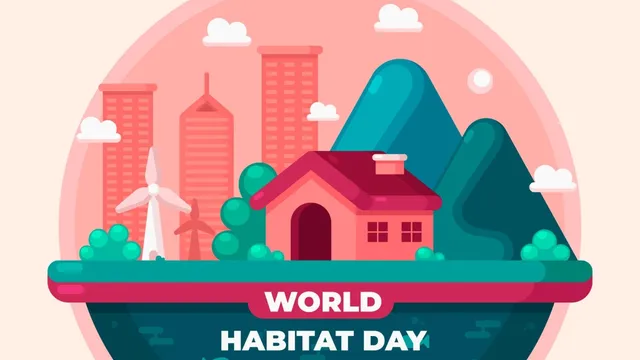- By Dr Sadhana Kala
- Mon, 06 Oct 2025 12:00 PM (IST)
- Source:JND
India’s cities are at the crossroads of growth and sustainability — balancing rapid urbanisation with the urgent need for climate resilience and inclusivity.
A Day to Rethink How We Build and Live
The theme for World Habitat Day 2025, “Resilient Urban Economies: Cities as Drivers of Growth and Recovery,” is particularly relevant for India, where urban centres serve as both engines of growth and epicentres of inequality.
India's cities, which are home to nearly 36% of the population, contribute over 60% of the national GDP. Yet, millions still live in inadequate housing or informal settlements. As the country moves toward its Viksit Bharat 2047 vision, the methods by which India builds, governs, and sustains its cities will significantly shape its future.
India’s Urban Paradox: Prosperity and Precarity
Cities like Bengaluru and Hyderabad have emerged as global tech hubs, while metropolitan areas such as Mumbai and Delhi continue to attract opportunities. However, India is grappling with an urban housing shortage of 18.8 million units, according to the Ministry of Housing and Urban Affairs (MoHUA). Almost all of this deficit impacts low-income and economically weaker sections (EWS/LIG).
This situation illustrates India’s urban paradox: cities foster prosperity but also exacerbate inequality. Well over 65 million Indians live in informal settlements, lacking reliable access to water, sanitation, and secure tenure. Thus, the goal of World Habitat Day is not only to celebrate urban progress but also to advocate for equity in its benefits.
Climate Change and the Urban Reality
Urban India is already at the frontline of climate change. Over the past decade, we have witnessed severe floods in Chennai and Mumbai, extreme heatwaves in Delhi and Ahmedabad, and landslides in hilly cities like Shimla—all exacerbated by unplanned growth.
The Indian Institute for Human Settlements (IIHS) reports that 70% of India's urban infrastructure projected for 2030 remains unbuilt. This presents an urgent opportunity to adopt climate-smart urban planning; green roofs, efficient drainage systems, solar energy integration, and electric mobility must become standard practices rather than exceptions.
Initiatives such as the Smart Cities Mission and the National Urban Digital Mission (NUDM) represent initial steps toward embedding sustainability into the fabric of India’s urban landscape. However, the long-term resilience of these efforts will depend on the inclusivity and transparency with which these technologies are implemented.
Housing for All: India’s Commitment
The Pradhan Mantri Awas Yojana (PMAY-Urban), launched in 2015, is India’s flagship program aimed at providing affordable housing for every citizen. By 2025, over 1.2 crore homes have been sanctioned, with 80 lakh completed. Nonetheless, the challenge goes beyond mere construction statistics; it is essential to ensure that homes are affordable, resilient, and environmentally friendly.
India’s building sector accounts for approximately 22% of the country's national CO₂ emissions. The future of housing must prioritize eco-friendly materials, passive ventilation, and circular construction models that minimize waste and reduce energy consumption. Policies that promote green architecture and the integration of renewable energy can transform housing projects from liabilities into climate assets.
Digital India, Digital Cities
Urban transformation in India is not solely about physical infrastructure; it also encompasses digital innovation. The rise of digital governance, smart infrastructure, and the inclusion of financial technology is reshaping urban operations.
Platforms like Velar, a decentralised finance (DeFi) protocol built on Bitcoin, illustrate how blockchain technology can create transparent, secure, and inclusive financial systems—qualities that urban governance urgently requires. Velar’s model of user ownership, decentralisation, and identity sovereignty aligns with the principles of sustainable cities: empowering individuals while fostering trust across systems.
Imagine applying this philosophy to urban governance, verifying property records, subsidy flows, and utility payments on secure, tamper-proof ledgers. Blockchain could serve as the invisible framework for the next generation of Indian cities—transparent, participatory, and resistant to corruption.

As India approaches its centenary of independence in 2047, urbanisation will be the defining force of transformation. (Image:Free)
Inclusion: The Heart of Urban India
Cities flourish when people thrive. Yet, for millions of migrant workers and informal labourers, access to adequate housing and essential services remains elusive. The Affordable Rental Housing Complexes (ARHC) scheme and community-led housing initiatives are crucial steps toward ensuring that those who contribute to building our cities can also live in them with dignity.
As Mahatma Gandhi wisely stated, “Be the change you want to see in the world.” India’s cities must embody this ethos—not only in their impressive skylines but also in their social foundations.
Women and Urban Sustainability
Women play a vital role in the urban ecosystem, fulfilling the roles of workers, caregivers, entrepreneurs, and citizens. Nevertheless, they face significant challenges, including unsafe transportation, inadequate sanitation, and housing insecurity.
Organisations such as the Mahila Housing SEWA Trust (MHT) are at the forefront of empowering women to become agents of change. They lead projects focusing on solar rooftops, waste recycling, and water management. Additionally, the PM SVANidhi scheme has enabled over 50 lakh women vendors to access microcredit and digital payment systems, thereby integrating them into the formal economy.
Implementing gender-sensitive urban design, which includes safe streets, accessible toilets, and equitable public spaces, is not just a progressive policy; it is essential for creating sustainable cities.
Youth and Innovation: Designing the Future City
With a median age of 28, India's youth are not only residents but also the architects of the nation's urban future. They are pioneering solutions, from AI-driven flood prediction systems to modular eco-homes, addressing the challenges of the 21st century.
Government initiatives like the Atal Innovation Mission and Urban Living Labs within the Smart Cities framework promote this creative energy. However, cities must go beyond these initiatives; they need to connect young minds with real urban challenges to turn innovation into inclusion.
When young people view their city as a canvas for creativity, sustainability evolves from a mere policy directive into a lived experience.
Circular Cities: Turning Waste into Wealth
Urban India generates about 65 million tonnes of waste each year, with nearly half going untreated. The Swachh Bharat Mission – Urban (SBM-U 2.0) is making strides in waste segregation and composting. However, the next critical step is to transition to a circular economy that turns waste into opportunities.
Startups are emerging that create roads from recycled plastic, while municipalities are monetizing compost. The concept of “waste-to-wealth” is becoming an increasingly viable industry. With effective regulation and active citizen participation, India can transform its waste crisis into a driver of a green economy, creating jobs, reducing pollution, and conserving resources.
Sustainable Mobility: Moving People, Not Just Vehicles
India’s cities lose over ₹1.5 lakh crore each year due to traffic congestion and pollution. The National Electric Mobility Mission Plan, along with the expansion of metro and e-bus networks, represents positive shifts toward sustainable transportation.
However, electric vehicles alone will not resolve congestion. The future lies in integrated, multimodal, and inclusive mobility, which incorporates pedestrian-friendly designs, cycling tracks, and last-mile connectivity to ensure accessibility for all citizens, including individuals with disabilities.
Indore, which has recently been recognised as India’s cleanest city for the seventh consecutive year, serves as a model that combines cleanliness, efficient public transportation, and active civic participation.
Policy, People, and Decentralisation
Sustainable cities cannot be created solely from the top down. They require decentralised governance, community participation, and effective public-private partnerships.
India’s alignment with the United Nations’ New Urban Agenda (NUA) reflects this vision: cities that are inclusive, safe, resilient, and sustainable.
Decentralised financial platforms like Velar provide a compelling analogy: in these systems, trust, ownership, and participation are shared among users rather than concentrated in central authorities. This collaborative spirit is what India must infuse into urban governance, fostering shared responsibility among all stakeholders.
A Vision for 2047: India’s Urban Future
As India approaches its centenary of independence in 2047, urbanisation will be the defining force of transformation. NITI Aayog projects that by 2036, 600 million Indians will reside in cities, necessitating an entirely new approach to housing, transportation, and livelihoods.
The blueprint for Viksit Bharat’s cities is built on four essential pillars:
1. Affordability: Providing housing and basic services for all income groups.
2. Resilience: Developing climate-proof infrastructure and adaptable systems.
3. Decentralisation: Empowering citizens through participatory governance.
4. Sustainability: Implementing low-carbon, resource-efficient urban planning.
By aligning innovation with empathy and technology with equity, India can create cities that are not only engines of growth but also guardians of humanity.
Conclusion: Building Homes, Building Hope
World Habitat Day reminds us that a home is more than just four walls—it is a foundation for dignity, security, and a sense of belonging.
From the PMAY housing drive to Velar’s decentralised model of empowerment, and from slum redevelopment in Mumbai to green innovations in Kerala, India’s urban journey reflects resilience and reinvention.
Governments alone cannot build the future; citizens, innovators, and digitally connected, environmentally conscious, and socially inclusive communities must collaborate.
As Gandhi’s timeless words remind us, “Be the change you want to see in the world.” On World Habitat Day 2025, that change begins with how we build—not just homes, but hope.
(Note: Dr (Prof) Sadhana Kala is a USA-trained robotic & laparoscopic surgeon, Uppsala University, Sweden, trained fertility specialist, Icon Endoscopic Surgeon of North India, and National Icon Endoscopic Surgeon of India. She is rated as India's Best Gynecologist by Google.)
(Disclaimer: The views expressed in this article are the personal opinions of the author.)

